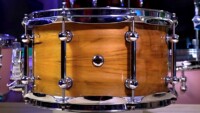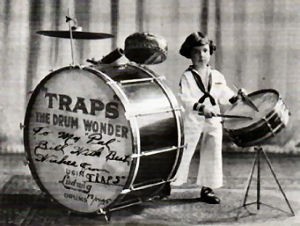 We first put up this tribute at the start of 2017, but we thought it was fitting as the site went live on his birthday to revisit it, and again have a look at the life of Buddy Rich.
We first put up this tribute at the start of 2017, but we thought it was fitting as the site went live on his birthday to revisit it, and again have a look at the life of Buddy Rich.
“Bernard ‘Buddy’ Rich, was born on September 30th, 1917 so we’re just a bit early with celebrating the centenary of the man who became known as – the world’s greatest drummer, ever.”
As I’ve written before, the last part of this sentence just happens to be the truth, the whole truth and nothing but the truth. And, anybody who knows anything at all about drums couldn’t possibly give you a plausible argument against that statement.
The absolute reality of it is, he was the greatest and unfortunately, unlike a lot of the drummers of my generation, I never actually got to meet him. He did come into my Drumstore in the late Seventies but I never got to meet him – I was away touring America with Don McLean at the time so I missed my opportunity.
To begin at the beginning, Buddy was born in Brooklyn, New York into a Jewish family and his parents were Bess and Robert Rich. At one year old his father discovered he could keep a steady beat on the spoons and six months later started him out on the stage in the family business, a Vaudeville act called ‘Wilson and Rich’. He appeared on Broadway at four, billed as ‘Traps The Drum Wonder’, with a large bass drum which announced that indisputable fact, which he hid behind. The bass drum was changed every so often by the Ludwig Drum Company as he grew taller! Eventually Ludwig must have run out of bass drums for him around the time he got to 28” tall. Unless of course The Ludwig Drum Company built special sizes for him…
To tell the truth I’ve scoured the internet and don’t know what the act consisted of, but chances are it had the young Bernard hiding behind the bass drum and jumping-out at an opportune moment while wearing a sailor suit. He could sing and dance and at the time was the second highest-earning juvenile in America taking home $1000 a week, close behind Jackie Coogan. There is much evidence that he went to Australia with the act and seems to have stayed there for quite some time – possibly because of the education laws in the USA. Certainly Dave Panici (the owner of the ‘attempted beard’ – see Youtube) claims Buddy had no formal education and it’s difficult to see how he could ever have gone to school with the work schedule he had. Mind you, his education should effectively have been completed in 1980, when he received an honorary doctorate from Berklee College of Music!
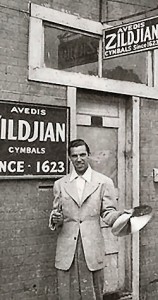 By the time Buddy was 11 years old he was already a fully-fledged bandleader. By the time he reached the ripe old age of 20, he was playing firstly with Joe Marsala, then with Jack Lamaire. In consecutive years he played with Bunny Berrigan and Artie Shaw. In 1937, when for once he wasn’t on the road, he was teaching comedian and film-maker Mel Brooks to play drums. Mel had sat (and he thought secretly) on Buddy’s drums, and was deemed by Buddy to be – “Not bad, but not good!”
By the time Buddy was 11 years old he was already a fully-fledged bandleader. By the time he reached the ripe old age of 20, he was playing firstly with Joe Marsala, then with Jack Lamaire. In consecutive years he played with Bunny Berrigan and Artie Shaw. In 1937, when for once he wasn’t on the road, he was teaching comedian and film-maker Mel Brooks to play drums. Mel had sat (and he thought secretly) on Buddy’s drums, and was deemed by Buddy to be – “Not bad, but not good!”
Buddy’s first recording was in 1938 with Vic Schoen whose band backed the Andrews sisters. Around this time he played with Tommy Dorsey’s orchestra where he met and played with Frank Sinatra with whom he remained friends throughout his life. He left to join the US Marines where he stayed for a couple of years before (some reports say) being given a Medical Discharge whereupon he rejoined Tommy Dorsey. Frank Sinatra put up $40,000 to get Buddy’s first big band on the road which lasted for a couple of years before it went out of business. After this he played with anybody who mattered including Harry James, Benny Carter, Les Brown, Charlie Ventura and Jazz at the Philharmonic.
He stayed with Harry James from 1954 to 1966 possibly because he paid him $15,000 a week which at the time was way more than anyone else in jazz was getting. Eventually he started another big band of his own. This gamble was a testament to his temperament, tenacity and (possibly) pure bloody-mindedness since by this time the Beatles and the rest of the British Invasion had arrived on US soil and the writing was definitely on the wall for big bands.
As I said he’d played gigs and made records with jazz royalty like Ella Fitzgerald, Charlie Parker, Louis Armstrong, Nat King Cole, Oscar Peterson, Ray Brown, Herb Ellis, Dizzie Gillespie as well as just about all the greatest contemporary drummers of the time.
Buddy Rich was such an explosive drummer that you’d be forgiven for thinking that he didn’t play with brushes, but that wouldn’t be true. Notably he used them almost exclusively to great effect on ‘The Lionel Hampton, Art Tatum, Buddy Rich Trio’ album in 1955. And it’s interesting to note when he accompanied other people his playing was generally accepted to be more understated, sympathetic and less explosive – yet still recognisably Buddy Rich.
He was certainly a larger than life character and his drum battle with Animal on the hugely popular ‘Muppet Show’ betrays a huge sense of humour, although not necessarily a self-deprecating one.
It turns out his favourite song was “It’s Not Easy Being Green” which is of course Kermit The Frog’s torch song so it does seem to demonstrate he has a soft side. Of course, because of YouTube we know all about his tirades although, in most people’s humble opinion these certainly don’t diminish him as a drummer, nor as it happens, as a responsible bandleader. Whilst he was arguably not the world’s most diplomatic person all the time, he was indisputably its best drummer.
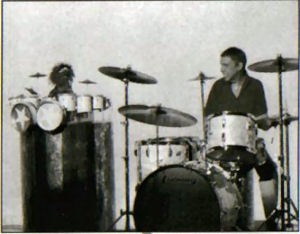 Although Buddy had influences, such as Tony Briglia who played in the Casa Loma Orchestra, he is famous for claiming he never having a drum lesson in his life although there’s a suspicion that Roy C. Knapp did teach him at one time. Buddy claimed lessons would mess up his musical talent. The closest he got to any formal musical education was with Henry Adler with whom he co-wrote a tutor book called ‘Buddy Rich’s Snare Drum Rudiments’. Adler always claimed he taught him nothing because it wasn’t necessary. He did however unsuccessfully try to teach him to read music. He failed mainly because his pupil was so busy working he never had the time to devote to it, and anyhow Buddy always had a drummer on hand at rehearsals to read new music whereupon he would listen intently to the piece and memorise it completely note for note. Adler realised by watching Buddy that it was something physical and mental you had to have to be a drummer. Buddy claims he never practiced, simply played the drums when he was performing. His view was you only got better by playing.
Although Buddy had influences, such as Tony Briglia who played in the Casa Loma Orchestra, he is famous for claiming he never having a drum lesson in his life although there’s a suspicion that Roy C. Knapp did teach him at one time. Buddy claimed lessons would mess up his musical talent. The closest he got to any formal musical education was with Henry Adler with whom he co-wrote a tutor book called ‘Buddy Rich’s Snare Drum Rudiments’. Adler always claimed he taught him nothing because it wasn’t necessary. He did however unsuccessfully try to teach him to read music. He failed mainly because his pupil was so busy working he never had the time to devote to it, and anyhow Buddy always had a drummer on hand at rehearsals to read new music whereupon he would listen intently to the piece and memorise it completely note for note. Adler realised by watching Buddy that it was something physical and mental you had to have to be a drummer. Buddy claims he never practiced, simply played the drums when he was performing. His view was you only got better by playing.
His formative years ‘on the boards’ were good training for show-business and besides drumming he could act, dance and sing. He even made several vocal albums – one where he sang the songs of Johnny Mercer, another called ‘Buddy Rich Just Sings’ and yet another ‘The Voice Is Rich’.
Buddy’s all-round-entertainer instincts died hard and because of his sense of humour (and caustic wit) he was in great demand on talk-shows around the world including Johnny Carson’s ‘The Tonight Show’, Merv Griffin, Dick Cavett, Steve Allen and Michael Parkinson.
He was a serial endorser playing WFL, Ludwig, Slingerland, Rogers and Vox before he ended up with a vintage ‘Radio King’ set. He seems to have stuck to the same sizes: 24 x 14 bass, 13 x 9 mounted tom, two 16 x 16” floor toms (one for his towel) and mostly a 14 x 5.5” snare drum. This snare drum was something of an anomaly because while he used Dynasonics, Supra-phonics and other high-end snare drums made by the companies he endorsed, for quite some time he used a Fibes drum without using any other instruments from Bob Grauso’s company.
Somehow he made all his kits produce a different sound to anybody else’s – better and somehow more drummy. He even made that restored Slingerland Radio King set he used from 1983 until the end, sound brighter than they usually are. As far as cymbals were concerned he played Zildjian: 14” Newbeat hi hats, 20” Medium Ride, 2 x 18” Crashes, 8 (or 10”) Splashes and a 22” Swish.
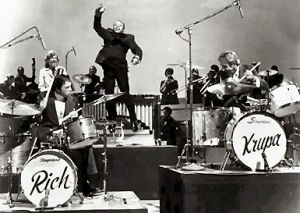 The following quotes may well be apocryphal but having read a lot about him I’m prepared to believe they’re the truth, the whole truth and nothing but the truth. So here goes:
The following quotes may well be apocryphal but having read a lot about him I’m prepared to believe they’re the truth, the whole truth and nothing but the truth. So here goes:
”If you don’t have ability, you end up playing in a rock band”.
“There are only two kinds of music – good and bad!”
“Almost everything I’ve done, I’ve done through my own creativity. I don’t think I ever had to listen to anybody else to learn how to play drums. I wish I could say that to 10,000 other drummers!”
The other side of the coin is something I believe he said in an advert: “An average band with a great drummer will sound great – a great band with an average drummer will sound average.”
Buddy may well have had the last laugh saying on what turned out to be his deathbed when questioned as to whether he was allergic to anything replied: “Yes, Country and Western music!”
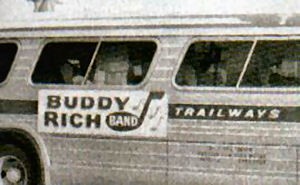 If you want to be entertained and possibly educated about the so-called ‘Scream Tapes’ I suggest you go to Buddy Rich on Wikipedia, scroll down to References and click on number 25: “I Got Nothin’ For You” where a chap called Richard Cooke interviews Dave Panichi, aka ‘The Beard’ and of course the object of Buddy’s derision.
If you want to be entertained and possibly educated about the so-called ‘Scream Tapes’ I suggest you go to Buddy Rich on Wikipedia, scroll down to References and click on number 25: “I Got Nothin’ For You” where a chap called Richard Cooke interviews Dave Panichi, aka ‘The Beard’ and of course the object of Buddy’s derision.
It’s perhaps germane to mention that all over the internet people have hedged their bets about Buddy Rich referring to him as arguably the world’s best drummer (even his own website does this!). For me there is no argument and singer (and also drummer) Mel Tormé encapsulated it in this statement:
“As regards my feelings about drummers, there’s Buddy Rich and there’s everybody else.”
Gene Krupa said: “Buddy Rich was the greatest drummer ever to have drawn breath!”
I realise I haven’t dwelled on the subject of his drumming prowess because frankly it’s not necessary. Suffice it to say he played all the rudiments: singles, doubles, multiples, triplets (broken or otherwise), drags and diddles; crisper, faster, with more precision and just better than anybody else. It goes without saying he swung and we don’t even have the satisfaction of saying he couldn’t rock. He could, but perhaps fortunately, he didn’t choose to! As far as what to listen to for the essence of him everybody’s favourites tend to be ‘The West Side Story Medley’, ‘Channel One Suite’ and of course Lennon and McCartney’s ‘Norwegian Wood’ from the album ‘Big Swing Face’.
He received lots of well-deserved awards and in addition to his doctorate at Berkley he was voted into both the Drumbeat and the Modern Drummer Halls of Fame.
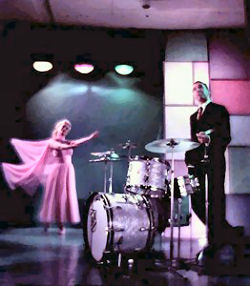 Buddy Rich died on April 2nd, 1987 and his reputation remains intact even as I write this appraisal 30 years later.
Buddy Rich died on April 2nd, 1987 and his reputation remains intact even as I write this appraisal 30 years later.
We asked around the friends of www.mikedolbear.com for quotes about Buddy, and this was what we got…
JoJo Mayer;
“From a drummer’s perspective, little can be said that hasn’t already been said about Buddy Rich. He changed the game.
But beyond that hides an untold story that came to my attention when I was asked to play his music and tried to get a better understanding of him. Buddy had the world at his feet ever since he was a kid. He was a celebrity. To be the most famous drummer in the world was his identity.
Then came the time where, out of nowhere, a drummer who banged-out minimalistic beats, and didn’t appear to hold his drumsticks properly, snatched Buddy’s place as the world’s most famous drummer. Ringo, who we love for different reasons than Buddy, also became richer than Rich ever would be (no pun intended). The game had changed.
Eventually Buddy, who had played with the greatest musicians in the history of Jazz, had to recruit music graduates in order to keep his big band on the road.
Understanding where he came from I can imagine this wasn’t easy for him. But he never slowed down and continued to always give everything he had. In fact, I think he played the best in his later years. And that to me is the inspiration and legacy of Buddy Rich. It’s where 1930’s Great Depression pragmatism, met indestructible – believe in creating wonder.
As at a time of his 100 year anniversary we experience an assault of game-changing events, it puts in perspective what greatness really means.”
Hal Blaine had this to say:
”I’ve often said the greatest compliment I ever received was from Buddy Rich. When Buddy produced his beautiful daughter Kathy’s album, I got the call from World Pacific Jazz Studios. This was my first meeting with The Legend. We did Kathy’s album and it was a great album. Our percussionist on the date was a great artist who had been doing so many recordings with all of us in LA, and happened to be a very close friend of the great Buddy Rich. He came to me after the session and said: “I just talked to Buddy and asked him why he didn’t play on his kid’s album” Buddy’s words, my hand to God: “I wanted the best”!!!
I’ve carried that in my stick bag of compliments through the years. I became immediate friends with Buddy and as I became more prominent in recording circles I never forgot those words. Buddy was a true legend! Not many around like him. He will always be the drum legend of legends!!!”
Steve Smith gave us the following paragraphs on the great man:
“I am in complete agreement with Bob’s heartfelt and informative tribute to Buddy Rich, “The World’s Greatest Drummer”. Fortunately I did see Buddy a number of times performing around the Boston area, starting in 1968, and once at this club in NYC, Buddy’s Place. To be in the room with him and hear him play was always mind-blowing! I was big-band fan and would drive long-distances to see his incredible big-band. I met him a couple of times and he was very cordial and polite. Over the past 20 years I’ve had the great opportunity to play with many of Buddy’s alumni and been privy to numerous — and never ending — “Buddy stories”. I won’t be relating any of those here, but after talking with such distinguished alumni as Steve Marcus, Andy Fusco, Chuck Findley, Bobby Shew and Pat LaBarbara, a common thread is this: they all loved Buddy and still think fondly of him as a person, and as a player he would astound them every night! And they all spent many YEARS playing with Buddy!
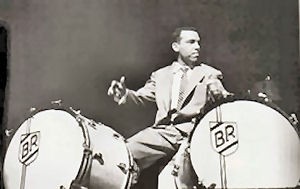 My comment on Bob’s statement, “And it’s interesting to note when he accompanied other people his playing was generally accepted to be more understated, sympathetic and less explosive – yet still recognisably Buddy Rich.” For some recordings where he played a sympathetic role to the point you may not recognize that it’s Buddy playing, listen to the albums Charlie Parker with Strings, Ella and Louis and Lester Young Trio. Sublime accompaniment.
My comment on Bob’s statement, “And it’s interesting to note when he accompanied other people his playing was generally accepted to be more understated, sympathetic and less explosive – yet still recognisably Buddy Rich.” For some recordings where he played a sympathetic role to the point you may not recognize that it’s Buddy playing, listen to the albums Charlie Parker with Strings, Ella and Louis and Lester Young Trio. Sublime accompaniment.
I’m thankful that Buddy Rich lived and left such an incredible body of work that we can still enjoy. I’m especially grateful that I was able to witness Buddy in person, which was always a life-changing experience.”
Pete Cater had this to say:
“These days the words ‘legend’ and ‘genius’ are used all too carelessly. Buddy Rich’s legendary status is beyond dispute given that almost thirty years after his passing he is still one of the most revered and talked-about players of our instrument. The mere mention of his name puts down a marker, sets a bar and represents the level of attainment for which we all strive. As a young player he was in the mould of Chick Webb, Jo Jones and Gene Krupa to name the obvious few. But it was as a much more mature player in his 40s and beyond that which to my mind displays his genuine originality of thought and his undisputed qualification for the genius tag. The earlier recordings both from the Big Band era and the action packed Verve imprints with Jazz at the Philharmonic are great, but for me it will always be the records of his big band from 1966 onwards that define his playing. He was noted as having little, or no reading ability. Thank heavens as otherwise he might have pursued a lucrative studio career and we wouldn’t have had the opportunity to see him up close on so many occasions. Buddy, along with Joe Morello, Louie Bellson and a supporting cast of others are the reasons why I got serious about playing all those years ago, and I consider myself deeply fortunate that almost fifty years later I am exactly the drummer I dreamed about being when I was six.
No him, no me. It’s as simple as that.”





